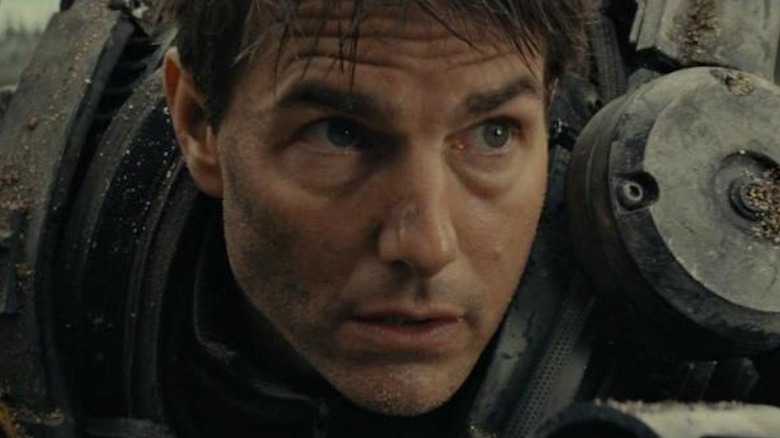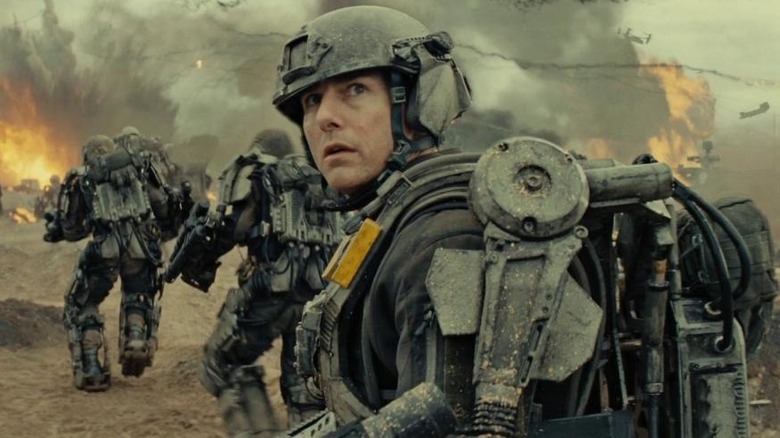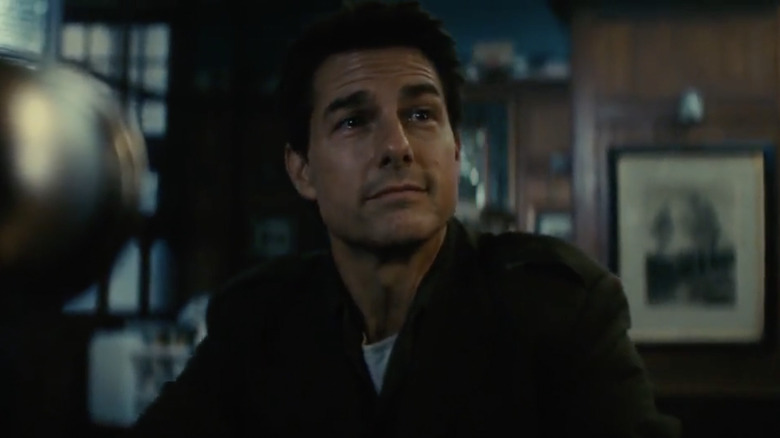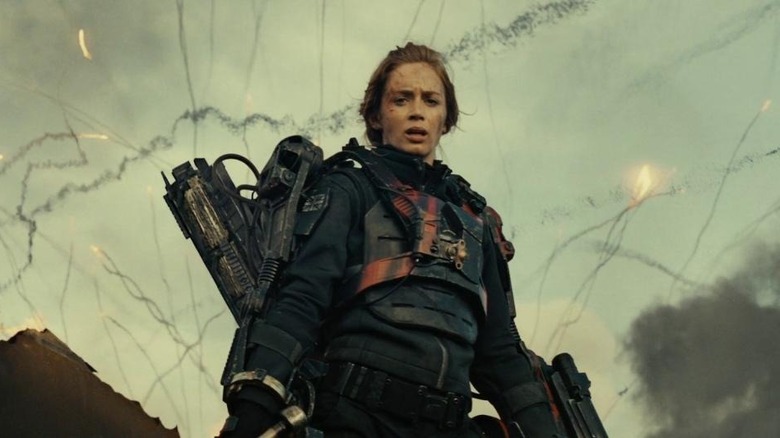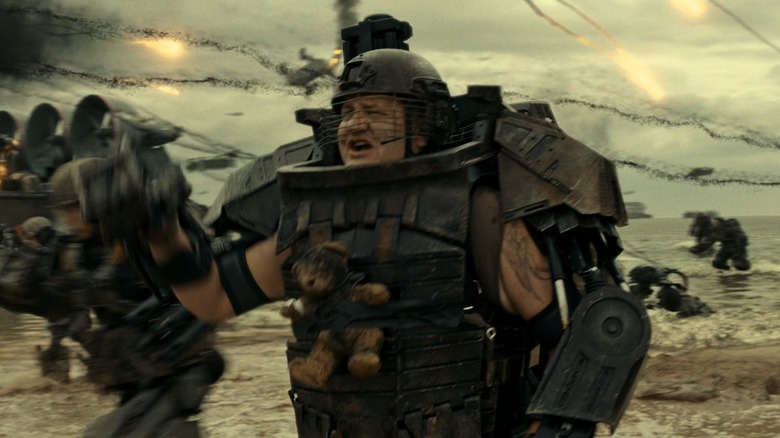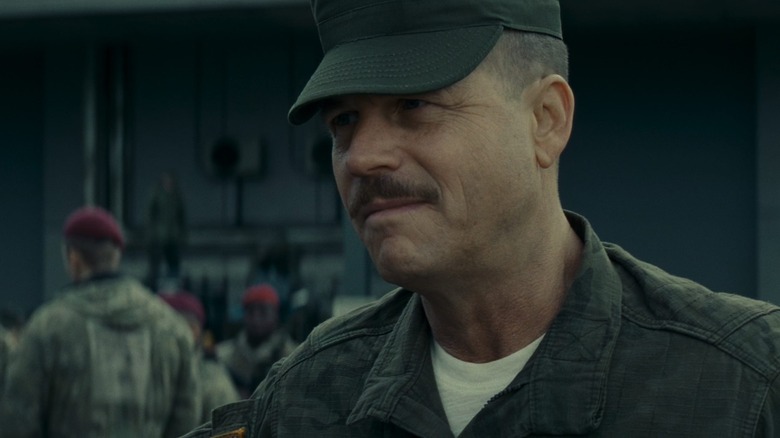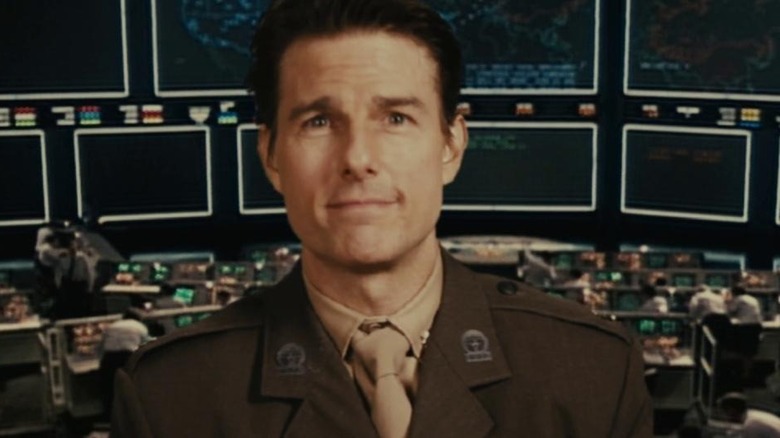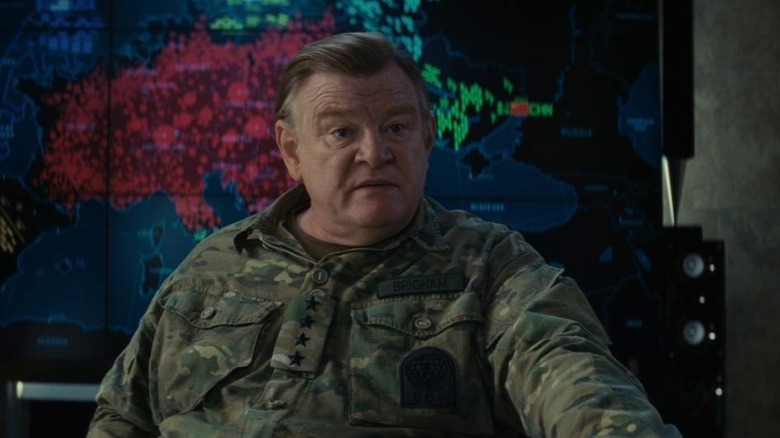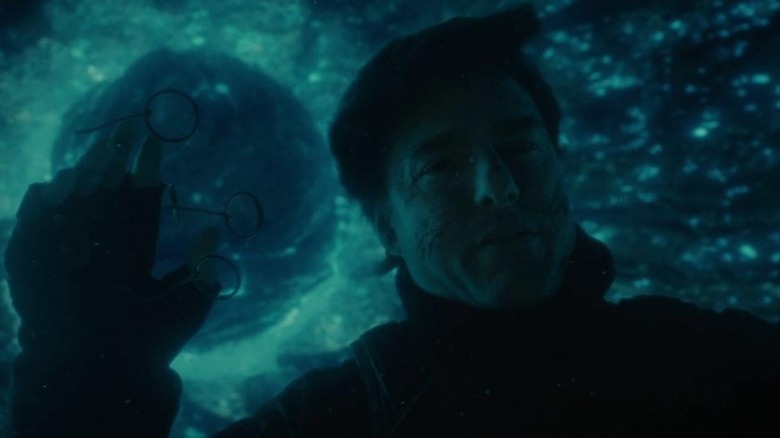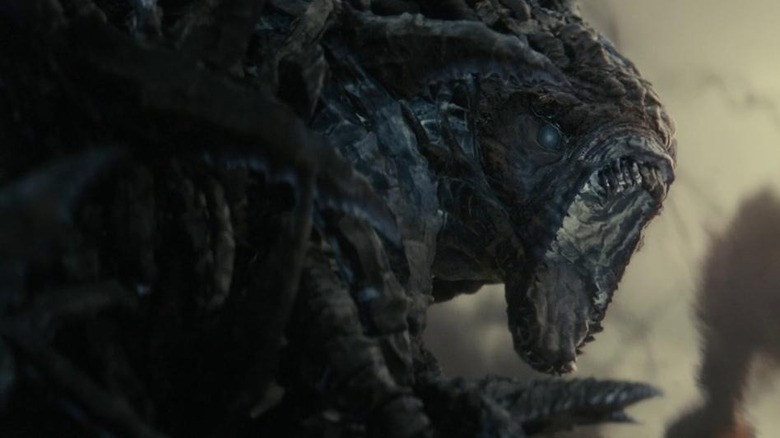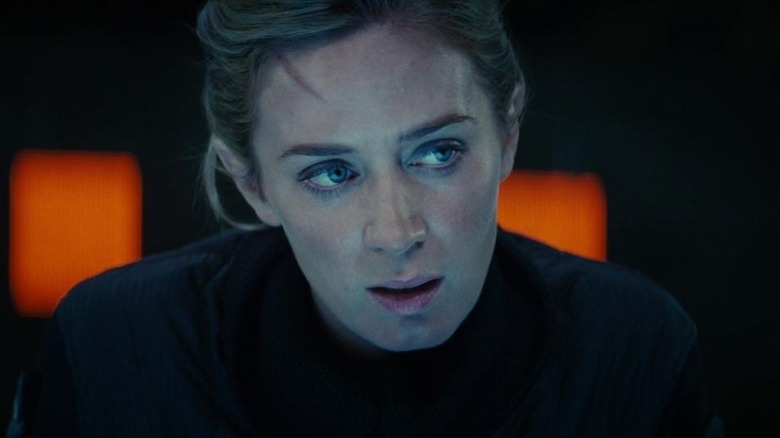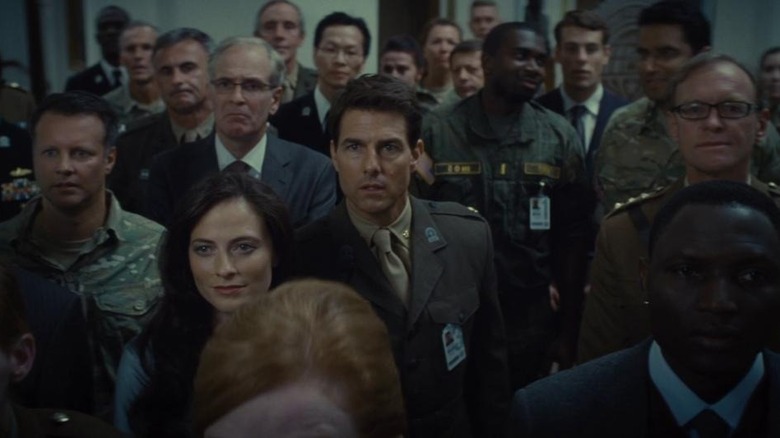Small Details You Missed In Edge Of Tomorrow
Is it too soon to declare 2014's "Edge of Tomorrow" a classic? Maybe we should just say that this massively entertaining, action-packed, and surprisingly hilarious sci-fi movie about aliens, time loops, and slow burn character development has a major place in our heart.
Tom Cruise stars as Major Bill Cage, a public relations expert whose unwillingness to fight the terrifying Mimics gets him unofficially — but convincingly — demoted to private and shoved into an armored battle-suit he barely knows how to operate. Against all odds, he manages to kill a Mimic ... and then finds himself living through the same day over and over (and over) again. Emily Blunt plays the hard-edged Rita Vrataski, who once went through the same thing and who has a plan to use Cage's newfound ability to win the war.
"Edge of Tomorrow" is an incredibly enjoyable movie, and it's easy to get so swept up in its compelling big picture that you miss some of the smaller details and implications. Luckily, there's never a bad time to go back for a rewatch — and when you do, here are some things you might want to look for.
The movie's war borrows elements from real life
During one time loop, Cage hears two men in a pub complaining that today's soldiers don't have real courage — not like their own fathers and uncles, who fought valiantly during World War II. They think the war with the Mimics is only dragging out because these days, nobody has what it takes.
We beg to differ — and not just because we've seen the movie's protagonists in action. Realistically, if the generations who fought WWI and WWII could meet the men and women going up against the Mimics, they would actually see a lot of traits that they recognize. "Edge of Tomorrow" grounds its alien invasion and futuristic technology in some of the most familiar details of the two world wars, and this creative decision helps to give the movie even more resonance.
In "Edge of Tomorrow," we see a war that's engulfed most of Europe and requires international alliances. As in WWI, France suffers an early blow and goes on to be the site of many grueling, devastating battles. Remember Verdun, where a time-looping Rita kills hundreds of Mimics? In 1916, it was also the location of the longest battle of WWI (per Imperial War Museums).
The war against the Mimics has an even stronger connection with WWII, which of course famously also had a key beach invasion that saw heavy casualties (via the U.S. Department of Defense). The movie was even released in the U.S. on June 6, the anniversary of D-Day.
Ordinary life goes on
"Edge of Tomorrow" has more than a few good "blink and you'll miss it" details, but our favorite might be the T-shirt J-Squad's Kimmel is wearing when Cage first meets him. Humanity has faced five years of slaughter, loss, and terror as the alien Mimics spread across Europe. Nowhere is safe, and everyone knows that the whole world's fate hangs in the balance. All the soldiers stationed at Heathrow know that their push into France could be a suicide mission.
And what is Kimmel wearing on the eve of battle? A screen-printed shirt that says "MIMIC THIS."
We're not being sarcastic when we say that it's good to know that even with the apocalypse on the horizon, people are still selling novelty T-shirts. It's just so human. Not only is it the perfect way of establishing that there are still pockets of relatively normal civilian life, it's also the perfect way of characterizing Kimmel's — and J-Squad's — sense of cheeky, rude defiance. That quality will eventually make them a key part of the victory over the Omega.
Another example of ordinary life comes when Cage takes a loop off and uses his honed expertise in escaping Master Sergeant Farrell's command to just go off somewhere and have a drink. He finds a small pub where two old, grumpy regulars are convinced the younger generation is (of course) botching everything. Some things never change, even with aliens on the horizon.
Cage could have met Rita a lot sooner
The montage of news footage that opens "Edge of Tomorrow" is all chaos, confusion, and hopelessness ... until Rita's stunning victory at Verdun. When that happens, public relations expert Cage is quick to capitalize on it, and we soon see him touting — and possibly coining — her nickname: the Angel of Verdun.
If Cage and Rita met each other before Cage started resetting time, it would completely change the texture of their relationship. Maybe it would be an asset, but considering how self-centered and image-focused Cage is at the beginning of the film, maybe it would only make things worse. We'll never know — and that in itself is a revealing detail about Cage's character. As one of the top public affairs officers for the United Defense Force, Cage not only could have met "the Angel of Verdun," he probably should have. He's using her as a key element in his message that the war is winnable; the least he could do is talk to her!
It says a lot about Cage that we see no evidence that he ever even tried. Before all his character development over the course of many time loops, he not only wasn't a hero — he wasn't emotionally engaged with or curious about the people around him at all. By the end of the movie, Cage has learned to connect much more deeply with everyone around him: not just Rita, but also J-Squad and even General Brigham's secretary.
The soldiers personalize their battle exosuits
As the website Design You Trust notes, soldiers have a long history of personalizing their gear. In "Edge of Tomorrow," we see that the tradition of graffitied helmets has not only stuck around, it's expanded into personalized exosuits. There's no way the soldiers of the UDF are going to trust their lives to this armor without marking it as their own.
In one simple but effective touch, we see a skull painted on one soldier's helmet: We'd call that a classic modification. Unsurprisingly, though, one of the weirder exosuit mods comes to us courtesy of Kimmel (Tony Way). Considering Kimmel's habit of being completely naked beneath his exosuit, it's easy to miss another eccentric touch: a teddy bear strapped to the front of his armor. We're not sure if it's superstition or sentimentality, but we know that Kimmel won't go into battle without it ... and that's a rule he doesn't have for minor things like underwear.
Sgt. Farrell's speech on fate foreshadows the rest of the movie
The late Bill Paxton was a cinematic treasure, and he makes Master Sergeant Farrell bizarrely charming. "Edge of Tomorrow" makes sure not to waste him — in fact, it trusts him to anchor a key scene. His particular mix of steel and eccentricity acts as a Trojan horse to smuggle in some very important foreshadowing.
When Farrell escorts Cage to the barracks, he catches J-Squad gambling and makes them eat some of their playing cards as punishment. It's obvious that Farrell and the raucous J-Squad have been through this routine so many times they know it all by heart; not only do they already know to start handing out the cards and chewing them up, they can already recite his lecture about how gambling presents chance as an inextricable part of fate. Farrell objects to that idea and even has J-Squad recite his core belief: "Through readiness and discipline, we are masters of our fate."
Farrell doesn't know just how right he is. Cage is about to go through time loop after time looper learning exactly how to become the master of his fate. He's going to save the world, and he'll have to develop basically superhuman levels of "readiness and discipline" in order to do it. We'd definitely call that coming around to Farrell's point of view.
The war propaganda is based on a lie
Partway through the movie, Cage finds out that his ability to reset time is effectively the one thing standing between humanity and a total Mimic victory. Not only are they brutally outmatched against an enemy that can overpower them physically and cosmically, all their previous hopes of winning the war — all the hopes Cage used to persuade wave after wave of new soldiers to enlist — were based on a lie.
We've seen Cage's masterfully deployed propaganda and how other people repeat it word-for-word ... and it's always centered on the "fact" that the armored, mechanized exosuits are such a game-changer that "Angel of Verdun" Rita Vrataski was able to kill hundreds of Mimics on only her first day in battle. What prospective soldiers don't know — but what we eventually find out alongside Cage — is that not only did the Mimics allow the UDF to win the Battle of Verdun, the time loops mean that Rita's "first day" in her armored exosuit was more like her thousandth. We see firsthand how Cage goes from someone who can't even work out how to turn off his safety to a battle-hardened expert all on his own "first day," thanks to repetition after repetition. Rita's experience at Verdun made using the suits look like child's play — but while they're helpful, they're not nearly that easy to master, and strapping someone into one definitely doesn't guarantee that they'll suddenly be able to fight.
General Brigham believes more of the time loop story than he's letting on
When Cage and Rita go to get Dr. Carter's prototype device — the one that can trace the link between a Mimic Alpha and the Omega — from the Ministry of Defence, Cage tells General Brigham that this isn't the first time they've tried to get Brigham to turn over the device. It might not even be the hundredth time. Every time, he says, Brigham refuses to give them the prototype. No matter what Cage says and no matter how much he can prove that he knows, Brigham never believes him.
At least ... Cage assumes Brigham doesn't believe him. The truth might be more complicated than that. If Brigham thought that Dr. Carter was a complete crackpot, why would he hold onto the prototype device at all? The United Defense Force punishes Carter for his "wild" theories by sticking him with relatively menial work on the sidelines, but Brigham doesn't treat the prototype like it's junk; he keeps it locked in a vault in his own office.
By holding onto the prototype and keeping it so secure, Brigham shows that on some level, he thinks it's possible that this really could be revolutionary technology in the war against the Mimics. And in that case, we're even more convinced that poor Dr. Carter got a raw deal.
The omega's vision trick still leaves it exposed
While Rita and Cage first believe — understandably enough — that the visions of the Omega are giving away its position, the truth is more sinister. The Omega isn't accidentally revealing its position while it searches for them; it's using false visions to lure Cage into a trap. If it can get him to an isolated location, it can set him up for another Alpha attack ... one that could potentially drain him of all his temporarily superpowered blood.
It's a good plan ... but even though it conceals the Omega's real location, it still gives away a lot more than it needs to. After all, without these visions, Rita and Cage wouldn't even know there was an Omega in the first place. As smart as the Omega is, it probably takes the rules of its own species for granted: It might not even think to conceal the mere existence of a central controlling organism. It might just assume humans already know that it exists, the way any human army would assume the other side has commanders and generals.
Basically, the Omega is smart enough to hide the location of its brain — but in doing so, it reveals that it's more or less a single entity, which isn't something the humans had any way of knowing before. That's game-changing information that means Cage and Rita can eventually win the war with a single attack.
The omega can't control its instincts
The Mimic Omega — which controls the rest of the collective — knows how to conceal itself, create and adjust battle tactics, and execute complex long-term strategies like fooling humanity into going ahead with Operation Downfall. Despite its obvious intelligence, however, it can't ignore what it perceives as a warning from its scattered nervous system. Resetting the day whenever an Alpha dies makes sense; it's a significant loss on the battlefield and one that may even indicate other problems, so of course it triggers a do-over. It's the alien equivalent of yanking back your hand when you touch something hot.
Like humans, the Omega seems to have a hard time controlling its reflexive response to danger, even when it knows the "threat" isn't actually real. It understands that Cage isn't actually an Alpha and shouldn't be part of its organic system at all, and it wants to correct the problem ... but nevertheless, it keeps resetting the day whenever Cage dies. It can't help it — for the Omega, the time reset is clearly an instinct as deeply ingrained as breathing.
Rita's past loops were even more horrific than Cage's
Cage's time loops are violent, lonely, grindingly repetitive, and full of people screaming at him; he would swap places with Phil Connors from "Groundhog Day" in a minute, no matter how many morning weather reports he had to endure. He gets called "maggot," gets labeled as a deserter, and sometimes, he gets shot in the head by the person he trusts the most. It's not a great deal, no matter how much he levels up in the process.
But as bad as Cage's time loops are, everything about Rita Vrataski suggests that hers were much, much worse. For one thing, she didn't have a previous Alpha-linked time looper to fill her in or understand what she was going through. She was incredibly alone — and to really twist the knife, she had to watch someone she cared about die over and over again until every detail was seared into her memory. To top it all off, whenever Rita tried to talk to her commanding officers about what was happening to her, they often had her committed to the psych ward. When they did believe her, they dissected her. It's hard to top that level of horror.
Cage takes on the omega's powers
The ending of "Edge of Tomorrow" has generated a lot of discussion and theorizing, especially since one element — Cage's final reset taking him back to his nap on the helicopter instead of his rude awakening at the base — can feel like a cheat. We've spent a whole movie watching Cage reset to one point on his timeline, so it's jarring when he suddenly wakes up before said point. Since that reset point leaves him in a much better, happier position, it's easy to feel like the movie has rigged things just for a happier ending.
Luckily, there's a key detail that makes it much easier to buy the upbeat ending we love. While a blood transfusion means Cage has lost the ability to reset time by the point he actually confronts the Omega, he soon gets another inadvertent exposure to Mimic blood ... and this time, it's the blood of the Omega itself. The Alphas might trigger the time travel, but the true power lies with the Omega. There's good reason to believe that Cage's final-act exposure to the Omega's potent blood not only lets him reset — the way he would if it were Alpha blood — but lets him control the reset, even if he doesn't know it. With that in mind, it's not surprising that he would take himself back to the helicopter. His subconscious knows that he wants a happy ending ... just like we do.
